The prehistoric world was home to an array of magnificent and fearsome creatures, and among them, the large cats ruled supreme. These ancient feline predators prowled the Earth with power and grace, displaying unmatched dominance. In this article, we will explore the top 5 largest prehistoric cats that once roamed the planet. From the mighty Smilodon with its deadly saber teeth to the massive American Lion, these awe-inspiring creatures left an indelible mark on the history of big cats.
Like all prehistoric counterparts of today’s animals, the prehistoric cats were usually larger, heavier, and more robust than today’s felines. Here are the top five largest prehistoric cats.
Please keep in mind that the list below is still controversial. It is based on the largest known specimens and can be changed at any time with a newly found fossil.
Prehistoric big cats’ sizes vs their living cousins
For comparison, male African Lions sometimes exceed 250 kg (550 lb) in weight. Reported body measurements in males are head-body lengths ranging from 170 to 250 cm (5 feet 7 inches to 8 feet 2 inches).
Male Siberian (Amur) tigers have a head and body length of between 190-230 cm (75-91 inches) and weigh between 180 to 306 kg (397 to 675 lb).
5. Xenosmilus

Xenosmilus hodsonae (from Greek, xenos, “strange” + smilē, “chisel”) is an extinct member of the Machairodontinae, or saber-toothed cats [commonly known as the saber-toothed tigers, they were not actually tigers though]. Physically, the cat measured up to 2 meters (6.6 feet) long with a highly muscular body and probably weighed up to 350 kg (770 lb).
Only Smilodon populator and Machairodus horribilis were noticeably larger amongst the saber-toothed cats. Xenosmilus was as big as most adult male lions and tigers, and was much more robust, with shorter, stronger limbs and a very powerful neck.
What sets Xenosmilus apart from other saber-toothed cats is its unique dentition. While most saber-toothed cats had long and slender upper canines, Xenosmilus had shorter and thicker saber-like upper canines. These canines were specialized to deliver devastating bites, allowing them to incapacitate their prey.
Based on the structure of its limbs and other anatomical features, it is believed that Xenosmilus was an ambush predator that relied on its strong jaws and muscular forelimbs to overpower and immobilize its prey. It likely hunted a variety of large herbivores that existed during its time, such as horses, camels, and other ungulates.
Two fairly intact Xenosmilus specimens were found by amateur fossil hunters in 1983 (1981 by some sources) in the Haile limestone mines in Alachua County, Florida. In 1994 the fossils were examined, and it was decided that the cats were of an entirely new genus.
4. American lion
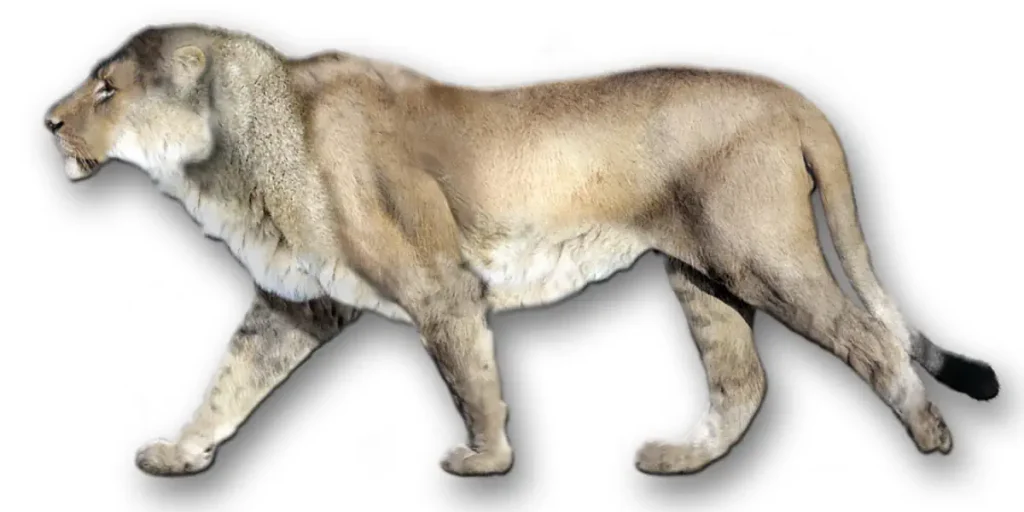
The American lion (Panthera leo atrox or P. atrox) is one of the largest types of cat ever to have existed, slightly larger than the early Middle Pleistocene primitive cave lion, P. leo fossilis, and about 25% larger than the modern African lion.
The head-body length of the American lion is estimated to have been 1.6-2.5 meters (5 feet 3 inches-8 feet 2 inches) and it would have stood 1.2 meters (3.9 feet) at the shoulder. Thus, it was smaller than its contemporary competitor for prey, the giant short-faced bear, which was the largest carnivoran in North America at the time.
The American lion was not as heavily built as the saber-toothed cat Smilodon populator. Sorkin (2008) estimated the American lion to weigh roughly 420 kg (930 lb), but a more recent study showed an average weight for males of 256 kg (564 lb) and 351 kg (774 lb) for the largest specimen analyzed.
3. Ngandong tiger

The Ngandong tiger (Panthera tigris
Although Raúl Valvert (2014) later estimated the straight length to be between 172 to 233 centimeters (5 feet 8 inches to 7 feet 8 inches), while the length over the curves was estimated to be 258 to 350 cm (between 8 feet 5 inches and 11 feet 6 inches). The minimum weight for females was estimated at 143 kg (315 lbs), although males can weigh up to 368 kg (811 lbs), with
2. Machairodus horribilis
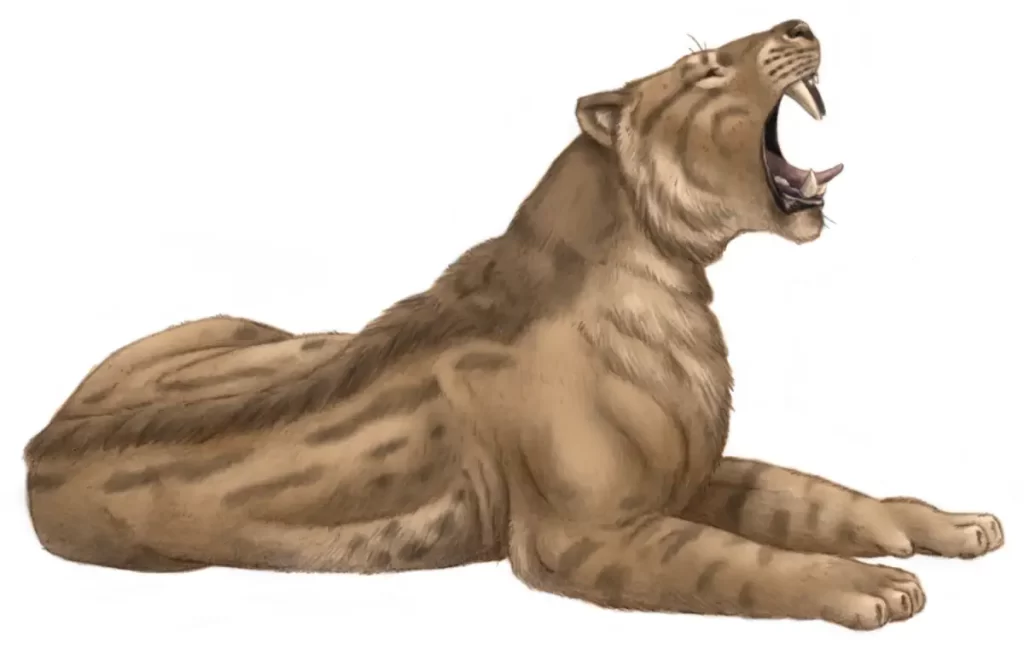
Machairodus was a saber-toothed cat that lived during the Late Miocene (11-5 million years ago) in Europe, Asia, Africa, and North America. A Machairodus horribilis skull found in 2016 in China measures over 16 inches (40 cm) long. That’s not only longer than all other known skulls of contemporary sabercats, but also those of the Ice Age celebrities Smilodon and Homotherium.
At maximum, largest living cats (with the exception of ligers, lion-tiger hybrids), tigers have a skull length of 14.8 inches (37.6 cm). If Machairodus horribilis had similar body proportions as a tiger, that specimen should be at least 248 cm (8 feet and 1.6 inches) in length (without tail). If it had similar body proportions as a lion, then it could be even longer, more than 285 cm (9 feet and 2.85 inches). This is about the size of a full-grown male polar bear!
Scientists think the specimen was about 405 kg (893 lbs) in weight.
Machairodus was probably hunting as an ambush predator. Its legs were too short to sustain a long chase, so it most likely was a good jumper and used its canines to cut open the throat of its prey.
1. Smilodon populator: the largest prehistoric cat

Perhaps one of the most famous prehistoric mammals, and the best-known saber-toothed cat, the Smilodon was more robustly built than any extant cat, with particularly well-developed forelimbs and exceptionally long upper canines.
Scientists long thought that the Smilodon populator was the largest prehistoric cat ever to roam Earth. It was temporarily de-throned in 2016 by Machairodus horribilis (see above). But, A Smilodon populator skull found in 2020 measured a whopping 16 inches (40 cm) in size, a measurement which effectively dwarfed previously found S. Populator specimens.
Smilodon populator was at least as large as Machairodus horribilis in size, but it was heavier and bulkier. Scientists think the new skull specimen was at least 435 kg (960 lbs) in weight, outweighing Machairodus horribilis which was estimated at about 405 kg (893 pounds).
The coat pattern of Smilodon is unknown, but it has been artistically restored with plain or spotted patterns.
Adult individuals typically weighed between 220 and 435 kilograms (485 to 960 pounds), although some exceptionally large specimens may have exceeded this range. In terms of length, they could reach up to about 3 meters (9.8 feet) from head to tail. As for height, Smilodon populator stood about 1.2 meters (4 feet) tall at the shoulder.
Smilodon was more robustly built than the modern big cats. It had a reduced lumbar region, high scapula, short tail, and broad limbs with relatively short feet. Smilodon is most famous for its relatively long canine teeth, which are the longest found in saber-toothed cats, at about 28 cm (11 inches) long in the largest species, S. populator.
Smilodon is commonly known as the saber-toothed tiger, but in fact, it is not closely related to the modern tiger (Panthera tigris) or any other living cat.
An apex predator, Smilodon primarily hunted large mammals.

Why did the saber-toothed tiger go extinct?
Saber-toothed cats possessed exceptional hunting skills, particularly when it came to taking down large prey. However, their specialization limited their abilities compared to the largest of the pantherine cats. Unlike the American lion, which could tackle both large and smaller prey in various habitats, the saber-toothed cats faced challenges.
With their short tails and hind legs, they had to be in close proximity to ambush their targets. On the other hand, the American lion had longer hind legs and tail, enabling it to pursue prey even if it changed direction during a chase.
The smilodon lacked this agility and explosive speed due to its shorter hind legs and the hindrance posed by its saber teeth when hunting smaller or medium-sized animals. As grasslands became more open, the saber-toothed cats struggled to hide and ambush effectively, becoming easily detectable by their prey.
Their inability to scavenge, coupled with their weak bite caused by the saber teeth, further limited their hunting options. In contrast, other cats of that era displayed a greater versatility in hunting a wider range of animals, including medium-sized prey found in forested areas.
![Largest prehistoric cats: Smilodon [saber-toothed tiger]](https://ourplnt.com/wp-content/uploads/2016/02/Smilodon-saber-toothed-tiger-1024x683.webp)
Largest living cat: the Liger
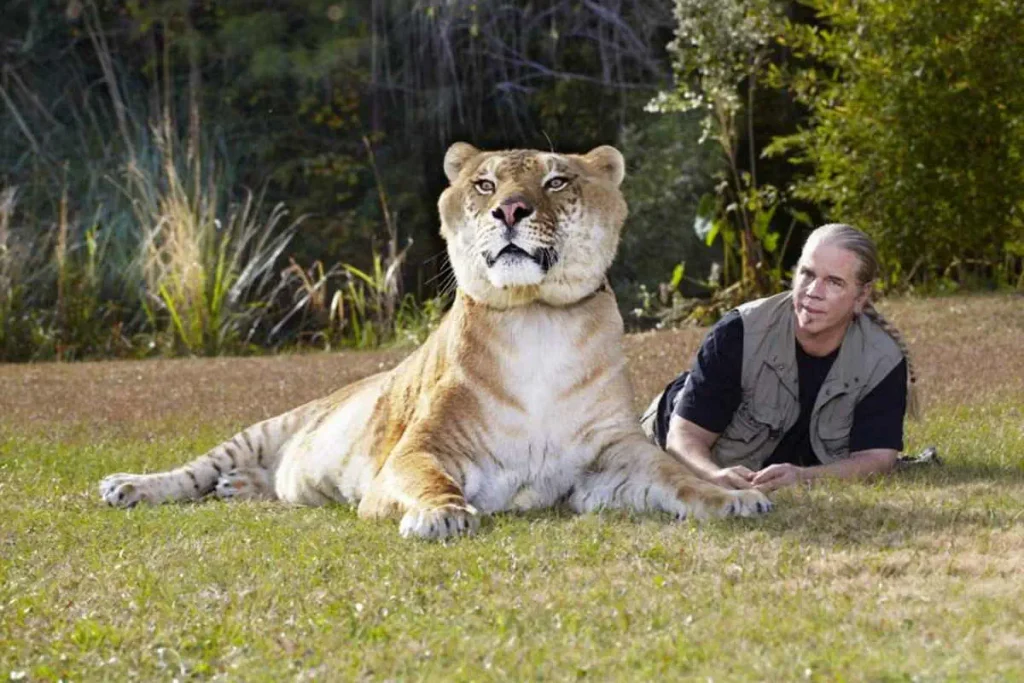
The liger, the largest of all known extant felines, is a hybrid cross between a male lion and a female tiger.
Hercules, the largest non-obese liger who lives at the Myrtle Beach Safari Wildlife Preserve in South Carolina, is the World’s largest living cat, according to the 2014 Guinness Book of World Records. He weighs 922 pounds (418.2 kg), is 131 inches (332.74 cm) long, and measures 49 inches (124.46 cm) tall at the shoulder.
Other big cat hybrids can reach similar sizes; the litigon, a rare hybrid of a male lion and a female tiglon, is roughly the same size as the liger, with a male named Cubanacan (at the Alipore Zoo in India) reaching 363 kg (800 lb). The extreme rarity of these second-generation hybrids may make it difficult to ascertain whether they are larger or smaller on average than the liger.
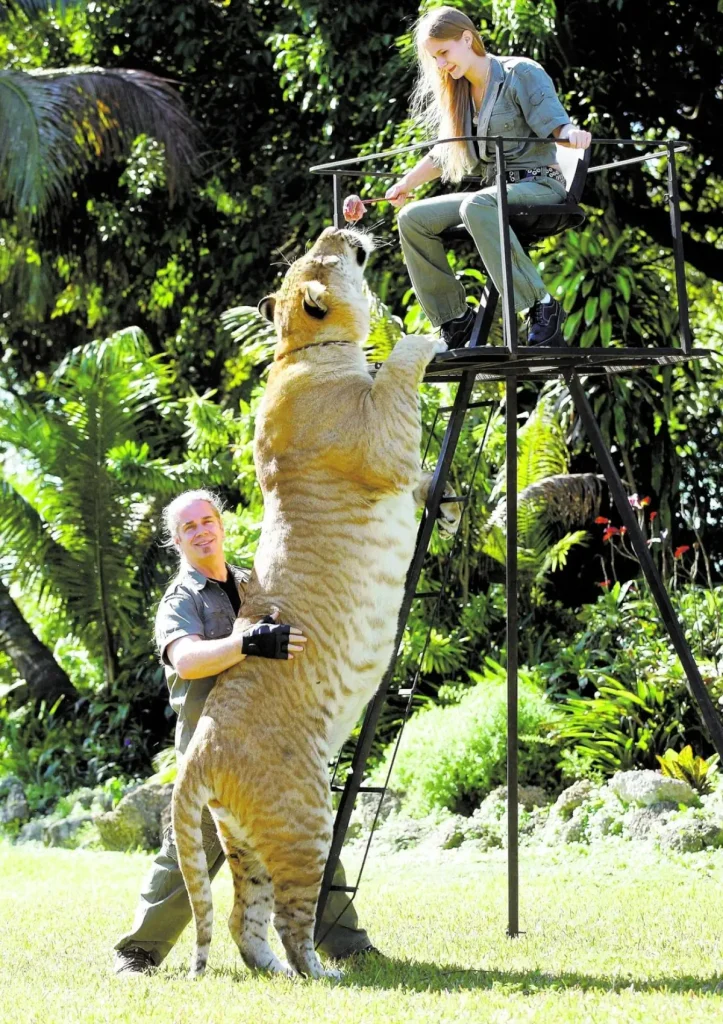
Related: 20 Amazing Liger Facts
Sources
- “The Biggest Saber Cat” on the Scientific American website
- “World’s Biggest Known Saber-toothed Cat Roamed the Earth 8 Million Years Ago and Was the Size of a Polar Bear” on the Chinese Academy of Sciences website
- Study: “A skull of Machairodus horribilis and new evidence for gigantism as a mode of mosaic evolution in machairodonts (Felidae, Carnivora)” (pdf)
- “Discovery Of 16-Inch-Long Saber-Toothed Tiger Skull Proves They Were Bigger Than We Thought” on the All That is Interesting website
- “They knew saber-toothed tigers were big. Then they found this skull.” on the New York Times website
- Machairodus on Wikipedia
- Ngandong tiger on Wikipedia
- Xenosmilus on Wikipedia
- American lion on Wikipedia
- Smilodon on Wikipedia
- Liger on Wikipedia
- How Many Elephants are Left in the World in 2025? - August 17, 2025
- Moon Landings: All-Time List [1966-2025] - February 2, 2025
- What Is Max-Q and Why Is It Important During Rocket Launches? - January 16, 2025
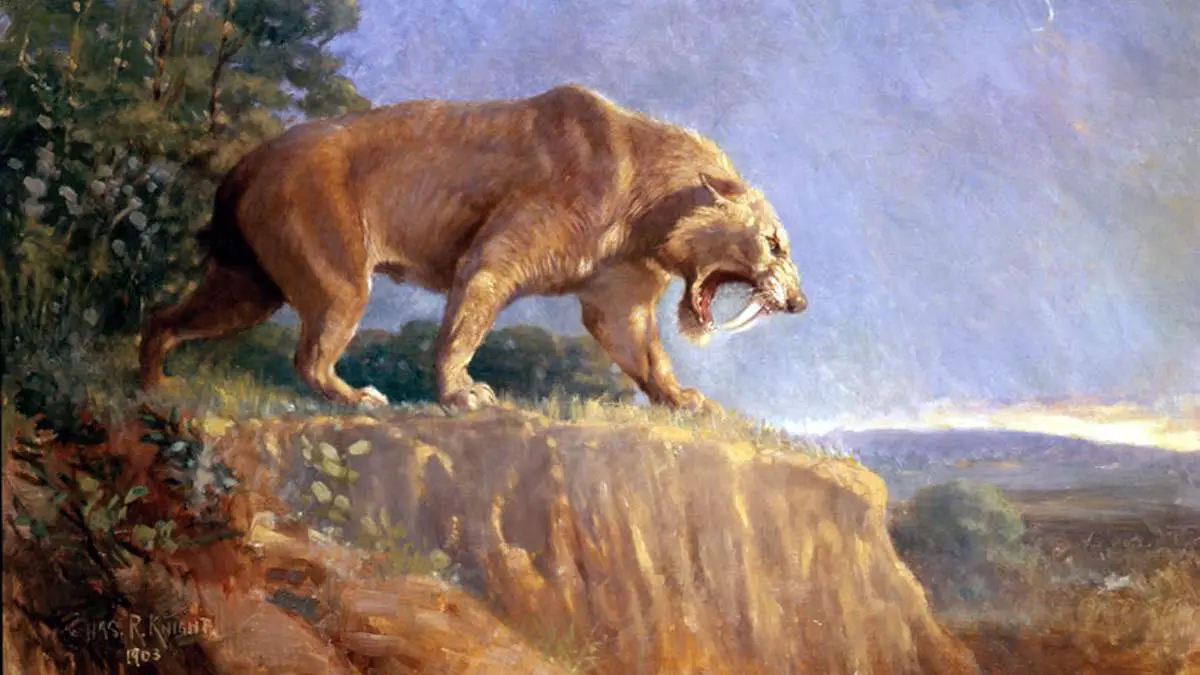
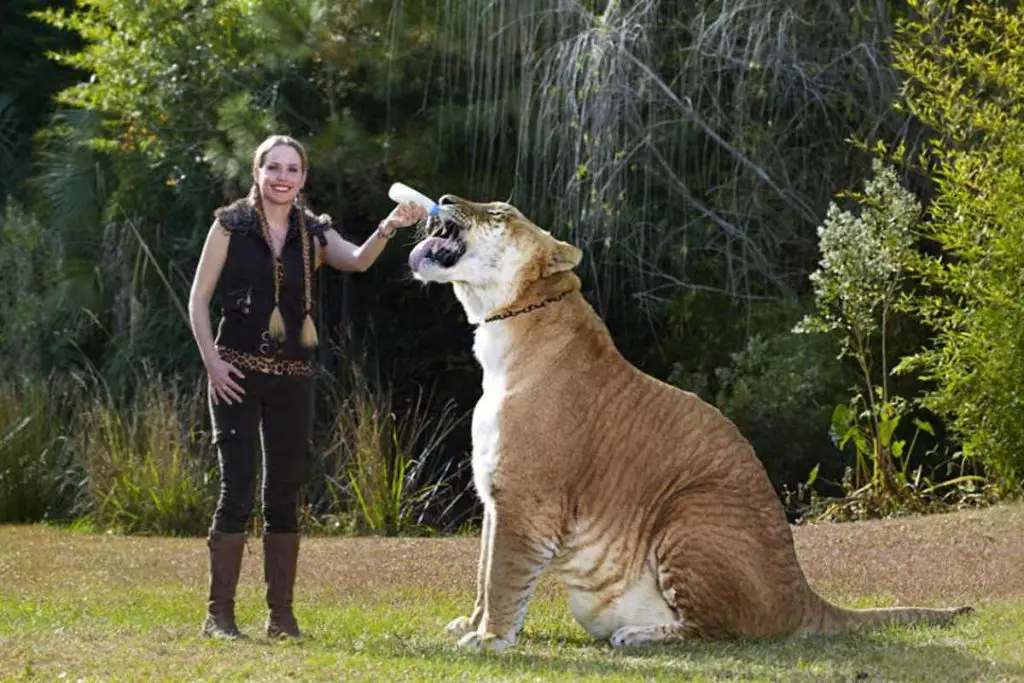

3 replies on “Top 5 largest prehistoric cats”
[…] Mediterranean, Thailand (Siamese), and others. But, domestic cats did not genetically morph from ancient wild cats into the modern pets that we know and love. In fact, most of the modern cat breeds we love as […]
[…] once sapiens and smilodons met? What a weird coincidence! […]
[…] -Ozgur Nevres, M. “Top 5 Largest Prehistoric Cats .” OurPlanet, 19 Feb. 2016, https://ourplnt.com/top-five-largest-prehistoric-cats/#axzz6OGme9LEu […]